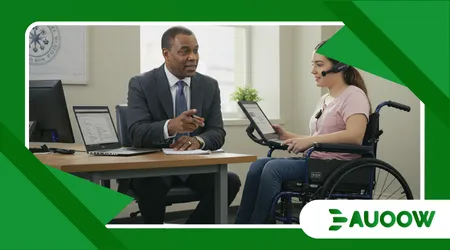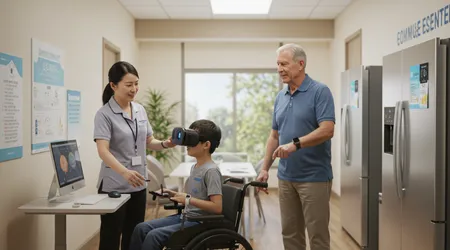Government Subsidies for Assistive Technology: Who Really Qualifies?

Government subsidies for assistive technology unlock life-changing tools for people with disabilities, but navigating eligibility feels like decoding a labyrinth.
In 2025, as societies prioritize inclusion, these subsidies bridge gaps in accessibility, empowering individuals to live independently. Yet, the question lingers: who truly qualifies for this support?
This article dives into the complexities of eligibility criteria, unpacks funding realities, and explores why access to these programs remains uneven.
With assistive technology (AT) transforming lives from screen readers to mobility aids understanding who gets help and why is critical. Let’s explore the policies, challenges, and opportunities shaping this vital public resource.
Assistive technology, from hearing aids to AI-driven prosthetics, is no longer a luxury but a necessity for millions.
Governments worldwide, recognizing this, offer financial aid to offset costs, which can soar into thousands of dollars. In the U.S., programs like Medicare and Medicaid lead the charge, while countries like the UK and India roll out targeted initiatives.
Still, eligibility rules often exclude those who need help most. This piece will break down the criteria, spotlight disparities, and propose smarter approaches to ensure fairness. Ready to unravel the system?
What Is Assistive Technology and Why Subsidies Matter
Imagine a world where a single device restores your ability to communicate or move freely. That’s the power of assistive technology.
Devices like wheelchairs, speech-to-text software, or braille displays enhance independence for people with disabilities. Yet, their price tags sometimes thousands of dollars create barriers.
Government subsidies for assistive technology step in to ease this burden, making tools accessible to those on fixed incomes.
These subsidies aren’t just financial relief; they’re a lifeline. Without them, many couldn’t afford devices that transform daily life.
For example, a powered wheelchair can cost $15,000, out of reach for most without aid. Subsidies signal a government’s commitment to equity, but their effectiveness hinges on clear, inclusive eligibility criteria.
The stakes are high. In 2022, the global assistive technology market was valued at USD 21.95 billion, projected to hit USD 31.22 billion by 2030.
++ How to Report Accessibility Violations: A Step-by-Step Legal Guide
This growth reflects rising demand, yet funding gaps persist. Subsidies must keep pace to ensure no one is left behind.
Subsidies also empower communities. When individuals gain independence, they contribute to society economically and socially.
Governments investing in AT subsidies aren’t just spending; they’re building stronger, inclusive societies.

Eligibility Criteria: Who Qualifies?
Eligibility for government subsidies for assistive technology varies by country, but most programs prioritize disability status and financial need. In the U.S., Medicare covers devices like mobility aids if deemed “medically necessary.”
Medicaid, meanwhile, requires proof of disability and low income. These criteria sound straightforward, but the reality is murkier.
Take Jane, a fictional 45-year-old with cerebral palsy. She needs a communication device costing $8,000. Medicare might cover it, but only if her doctor navigates a maze of paperwork proving necessity.
If Jane earns slightly above Medicaid’s income threshold, she’s stuck. Such rigid rules often exclude working-class individuals with disabilities.
Also read: The Role of Disability Advocacy Groups in Shaping Public Policy
In the UK, the Disabled Facilities Grant supports home modifications, but applicants must prove long-term disability and financial hardship.
Similar patterns exist globally India’s Ayushman Bharat scheme, for instance, targets low-income families but demands extensive documentation.
These hurdles raise a question: are subsidies truly reaching those they’re meant to help?
Globally, age can complicate eligibility. Some programs exclude younger applicants, assuming they have fewer needs.
Yet, children with disabilities often require early intervention, making timely access to AT critical.
| Country | Program | Key Eligibility Criteria | Challenges |
|---|---|---|---|
| USA | Medicare | Medical necessity, disability proof | Complex paperwork, delays |
| USA | Medicaid | Low income, disability proof | Income thresholds exclude some |
| UK | Disabled Facilities Grant | Long-term disability, financial need | Rural access limited |
| India | Ayushman Bharat | Low income, severe disability | Documentation barriers |
The Application Process: A Daunting Journey
Applying for government subsidies for assistive technology can feel like running a marathon with no finish line. In the U.S., applicants must submit medical records, financial statements, and device prescriptions.
Miss one document, and the process stalls. For someone like Carlos, a visually impaired retiree, gathering these papers while navigating vision loss is a Herculean task.
Delays are another hurdle. Approval can take months, leaving applicants in limbo. In 2025, some U.S. states report wait times of up to six months for Medicaid-funded AT.
Read more: Accessibility in Disaster Response: Are Emergency Plans Inclusive?
This lag forces people to delay critical support, impacting their quality of life. Streamlining applications could change this.
Globally, the story repeats. In India, the Ayushman Bharat scheme requires multiple verification steps, discouraging applicants.
Simplifying processes and offering digital submissions could make subsidies more accessible. Why should bureaucracy block access to life-changing tools?
Training on application processes is often absent. Community organizations could bridge this gap, guiding applicants through forms and requirements, ensuring no one is deterred by complexity.
Disparities in Access: Who’s Left Out?
Not everyone benefits equally from government subsidies for assistive technology. Rural residents, for example, face unique challenges.
In the U.S., 38% of non-elderly adults over four times the poverty level often self-employed or early retirees lose ACA subsidy eligibility, limiting AT access. Urban bias in program outreach exacerbates this.
Minority communities also face barriers. Language barriers and lack of awareness about subsidies exclude non-English speakers.
In the UK, ethnic minorities report lower access to Disabled Facilities Grants due to complex applications. Addressing these gaps requires targeted outreach and multilingual support.
Consider this analogy: subsidies are like a bridge to independence, but for many, the bridge is too narrow or too far away. Governments must widen access through education and inclusive policies to ensure no one falls through the cracks.
Socioeconomic factors compound disparities. Low-income families often prioritize basic needs over AT, even with subsidies. Tailored financial counseling could help them navigate these trade-offs.
Innovations and Future Directions
Technology is reshaping assistive devices, and subsidies must evolve too. AI-powered prosthetics and IoT-enabled hearing aids are game-changers, but their costs are steep.
Government subsidies for assistive technology need to cover these innovations to stay relevant. In 2025, the UK’s Spring Statement emphasized growth and reform, hinting at expanded AT funding.
Training is another frontier. The UK’s 2025 mandate for teacher assistive tech training shows promise.
Extending this to healthcare providers could ensure better device use. Governments should also incentivize R&D to lower costs, making subsidies stretch further.
Public-private partnerships could amplify impact. Imagine tech companies collaborating with governments to subsidize cutting-edge devices.
Such models could reduce costs and expand access, ensuring subsidies keep pace with innovation.
Global cooperation could also help. Sharing best practices like Canada’s streamlined AT programs could inspire reforms, making subsidies more effective worldwide.
Policy Recommendations: Building a Fairer System

To make government subsidies for assistive technology equitable, governments must act boldly. First, simplify applications.
Digital platforms with clear guidelines could reduce delays. Second, expand eligibility to include middle-income earners, who often fall through the cracks.
Outreach is critical. Governments should partner with community organizations to educate marginalized groups about subsidies.
Multilingual campaigns and rural-focused programs could close access gaps. Finally, fund training to ensure users maximize device benefits.
Consider a single mother with a hearing-impaired child. Subsidies could provide a hearing aid, but without training, its impact is limited.
Holistic policies covering devices, training, and maintenance would transform lives. Isn’t it time governments prioritized inclusion over red tape?
Investing in awareness campaigns is equally vital. Many eligible individuals don’t know subsidies exist. Governments could leverage social media and local clinics to spread the word.
A Call for Equity in 2025
The promise of government subsidies for assistive technology lies in their potential to empower. Yet, complex criteria and uneven access undermine this goal. In 2025, governments must streamline processes, broaden eligibility, and embrace innovation.
By doing so, they can ensure that assistive technology reaches everyone who needs it, not just those who navigate the system best.
This isn’t just about funding devices; it’s about dignity and independence. From rural farmers to urban retirees, everyone deserves access to tools that unlock their potential.
Let’s demand policies that reflect this truth, building a world where no one is left behind.
Governments have the power to rewrite this story. By prioritizing inclusion, they can turn subsidies into a universal right, not a privilege. The time for change is now.
Frequently Asked Questions
Q: Who qualifies for government subsidies for assistive technology?
A: Eligibility typically requires proof of disability and financial need, but criteria vary by country and program, often involving medical and income documentation.
Q: How long does it take to get approved for subsidies?
A: Approval times differ, but in the U.S., Medicaid-funded assistive technology can take up to six months due to bureaucratic delays.
Q: Can middle-income earners access these subsidies?
A: Many programs, like U.S. Medicaid, exclude middle-income earners, creating gaps. Some countries are exploring broader eligibility to address this.
Q: Are new technologies like AI prosthetics covered?
A: Coverage for cutting-edge devices varies. Some programs, like the UK’s, are expanding to include innovative technologies, but gaps remain.
